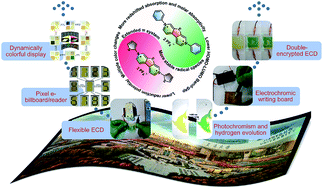π-Extended chalcogenoviologens with stable radical state enable enhanced visible-light-driven hydrogen evolution and static/dynamic electrochromic displays†
Abstract
A series of novel π-extended chalcogenoviologens with stable radical states, narrow band gaps and low reduction potentials were synthesized. These compounds can be used as photosensitizers and electron mediators for excellent visible-light-driven photochromism and hydrogen evolution due to their strong absorption in the visible region and fast electron transfer properties. Particularly, Se-PhV2+ (3b) showed the highest value reported to date for viologen-based visible-light-driven hydrogen evolution. The more stable radical-forming chalcogenoviologens (5 times more than methyl viologen) can be used as an active layer in the static/dynamic electrochromic displays with excellent performances. The wifi-controlled flexible ECD, electrochromic writing board, pixel e-billboard/reader and dynamic color display with a four-latticed pixel matrix were exploited to testify the better performance, including low operation voltage, high efficiency and energy-saving ability. In addition, a double-encrypted electrochromic display was developed for the first time, which could demonstrate “XJTU” and the school badge alternatively, controlled by the application of different voltages. This discovery not only provided potential implications for novel smart windows, but also laid the foundation for simplified energy-efficient colorful displays and future wearable devices.



 Please wait while we load your content...
Please wait while we load your content...